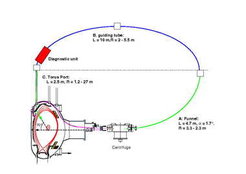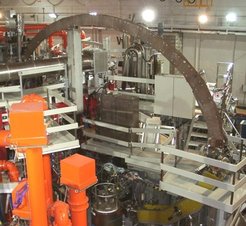Launching systems
1. Looping:
The funnel:
The funnel consists of two concentric elements: a rectangular, u-type guiding track made of a stainless steel foil and 5 mm high aluminium walls which is embedded in a preformed quarter ellipse fabricated from a glass fibre soaked epoxy compound. This part is aligned and fixed inside a d = 200 mm vacuum tube. Functionally, there are two planes to consider, the plane of the horizontal centrifuge scatter (+/- 3° at v = 240 m/s decreasing to +/- 1° at v = 1200 m/s) and that of the vertical centrifuge scatter (+/- 0.25°) corresponding to the elliptic plane. The horizontal scatter led to the design of convex walls diverting in the first part to follow the scatter (up to 100 mm) and leading to a 6 mm wide exit.
This shape ensured to maintain a chosen pellet impact angle throughout the funnel length. An exact angle of 1.7° was determined by tailoring the funnel length to fill a quarter of an ellipse (L = 4.76 m) in order to simplify the realization of the guide tube segment. Regarding the vertical scatter a maximum radius of curvature at the ellipse entrance had to be traded against the overall guiding track length. The radius of R = 3.3 m was chosen resulting in a radial impact angle of < 1.4°.

The guide tube segment:
For the guide tube segment a 4.3 x 10.7 mm u-type microwave guide is used, which is made from copper. The tube is anchored in an CF 40 vacuum tube and bended on a elliptically prepared wood frame. The segment is separated from the funnel by a vacuum valve creating a free flight zone of 40 mm. Alignment between the funnel exit tangent and the tube entrance is controlled not to exceed 0.1 mm by a vacuum-tight micropositioner. This allows to keep the radial entry impact angle very shallow despite a radius of R = 2 m. The 9 m long segment is followed by a 1 m diagnostic section situated as close as possible to the plasma. This unit is part of the permanent track connected to the tube via interchangeable couplings. The diagnostics incorporate a double light barrier and shadowgraphy complex.

The tokamak port segment:
The tokamak port segment ( 5 x 5 mm u-type-profile) puts extreme stress on the pellet with curvature radii changing between 25 and 1.5 m because of the specific port geometry (2 m long, 50 mm ID) and an poloidal injection angle of 72°.

